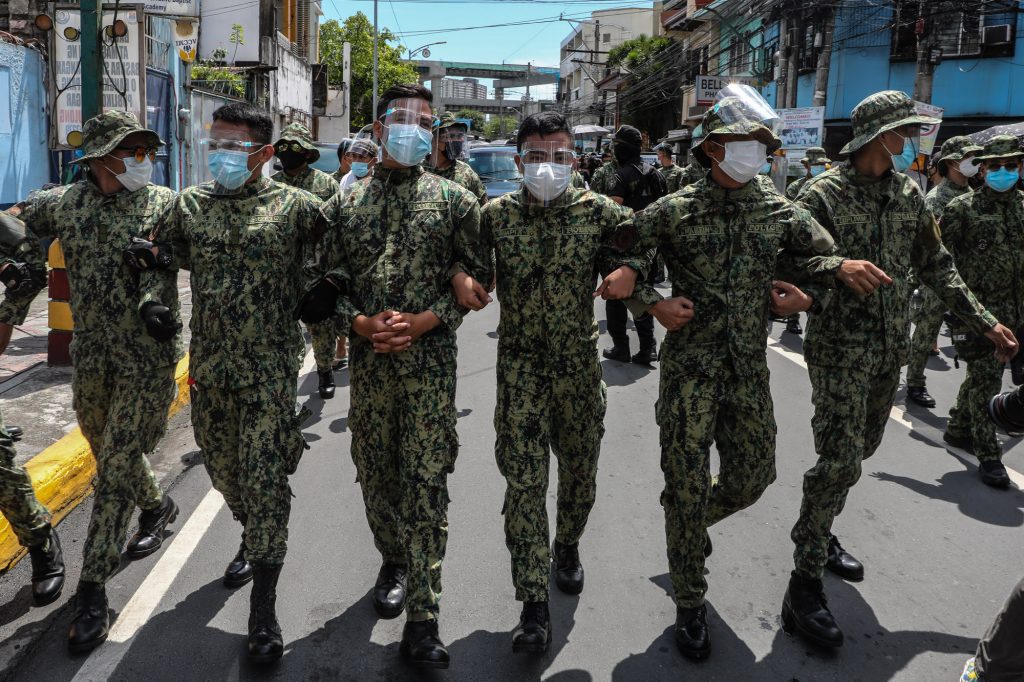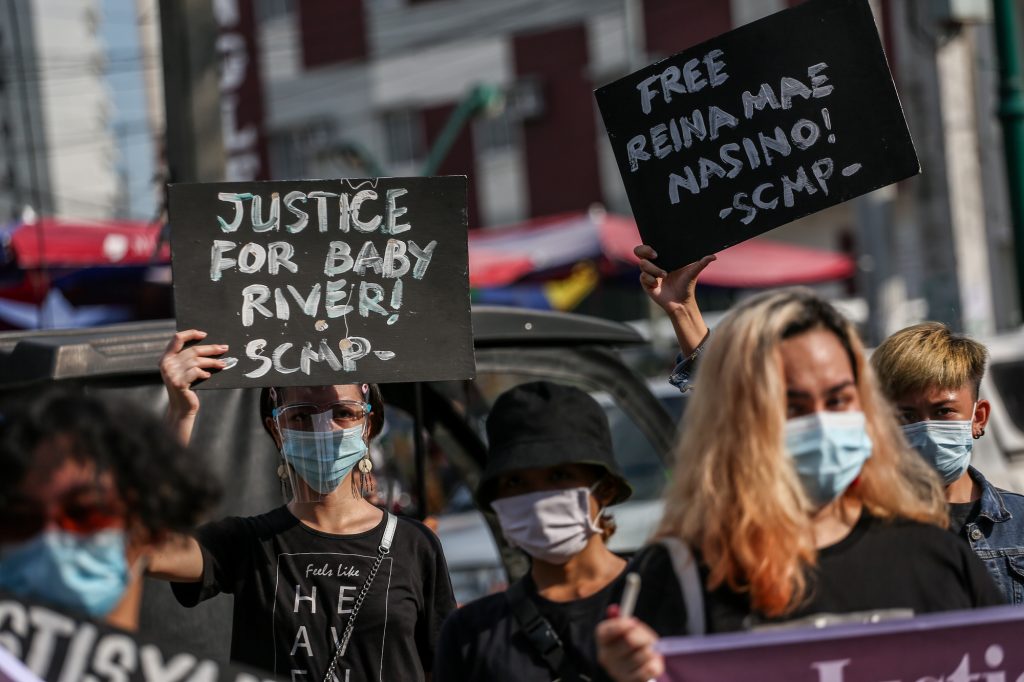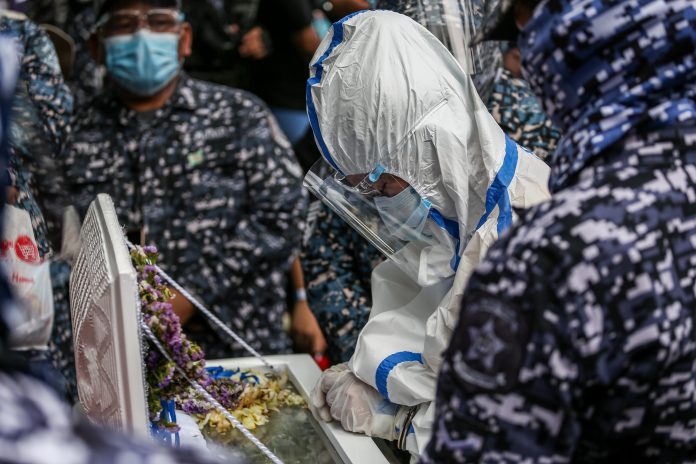It was the first sunny morning after a slew of rainy days. After having a bit of sun on my back, I switched on my laptop.
Topmost on my Facebook newsfeed sits a photograph of La Funeraria Rey where Baby River, the child of human rights activist Reina Mae “Ina” Nasino, lies in repose.
Outside, members of the Manila Police District riot squad line up in full battle gear, including shields and truncheons, barring mourners from entering the premises.
Karapatan, the non-government organization who posted the photograph, said “a fire truck and a SWAT mobile are also on standby along Laura Street”.
A day earlier I reshared from another account a photograph of 23-year-old Mommy Ina in full hazmat suit, handcuffed while attending her child’s wake. With her came a squad of armed officers barring journalists from getting their interview. In about an hour, the post went viral with 7.1 thousand shares.
As a caption to the photo, I wrote:
“There are many images of this administration’s inhumanity, but this one, above all, proves it is incapable of compassion, to say nothing of understanding the spirit of the law. Reina, the 23-year-old mother of Baby River, is not a threat to anyone. The court has yet to prove her guilt (she is presumed innocent until proven guilty). Still, authorities insist on leaving her in chains, like some serial killer, as she attends the wake of her dead child. Watch how this administration enforces humiliation and indignity as implements of their war against dissenting voices.”
Mommy Ina was arrested alongside two other activists in 2019. Authorities discovered she was in her first trimester after her medical examination in prison. Shortly after giving birth, prison authorities removed the child from the mother’s care, which in time led to the child contracting a fatal disease.
Despite appeals from Ina’s lawyers, authorities refused the mother all chances of being reunited with Baby River until the latter’s death.
Baby River’s death is a gross example of government neglect. Kapatid, a group comprised of the families of political prisoners, told the Inquirer, “Gross injustice and heartless. When Reina Mae Nasino first asked the court to take care of her child, prison officials opposed this for reasons that they have not enough personnel and they do not have a prison nursery, when in fact, it is the responsibility of the government to provide such facilities.”
After River passed away, the lawyers’ appeals for a furlough so the mother can attend to her child’s wake was cut short by the Manila Regional Trial Court from the previous three days to only two.
The court based its decision on the claims of the Bureau of Jail Management and Penology (BJMP) that it has limited personnel.
Yet, as photos have revealed, the government has sent SWAT teams, riot squads, and police officers to surround 23-year-old Mommy Ina as though she was a threat to the community.

The scene reminded me of a line by Uruguayan journalist Eduardo Galeano, who wrote, “The system of power that creates poverty is the same one that wages war without quarter on the desperate people it begets” (Galeano, Upside Down: A Primer for the Looking-Glass World, 1998).
In my country, to live life as a human rights activist is well-nigh considered a heinous crime. The most painful thing about fighting for one’s rights in the Philippines is when the poor have to ‘apologize’ for breathing the same air, eating the same rice, and for being alive, side by side with those in power.
The State treats its people the way it treats criminals and terrorists. So much so that even a 23-year-old activist will have to move heaven and earth if only to attend the wake of her dead child—a death resulting from clear government negligence.
The crackdown kicked off shortly after President Rodrigo Duterte sat in office in 2016. In the 674-page 29th Edition World Report 2019, Human Rights Watch (HRW) said “The government vilified activist groups, calling them communists and terrorists. In March, the foreign affairs secretary accused human rights groups of being ‘unwitting tools’ of drug syndicates […] There were violent attacks against human rights activists, lawyers, journalists, environmentalists, indigenous group members, peasants, and farmers.”
Brad Adams, executive director of HRW’s Asia Division, said in the report, “President Duterte has used the killing of thousands of largely poor drug suspects as a tool to bolster his popularity. He is also targeting anyone who might undermine that popularity, from outspoken senators to journalists documenting his abuses.”
That “popularity,” as foreseen by HRW’s report, reached its peak during a survey conducted by Pulse Asia in mid-September, saying that 91% of Filipinos “approve” of Duterte’s management of the pandemic.
While many easily dismissed the Pulse Asia survey as another “manipulated” effort to polish Duterte’s trust rating, others honed in on the processes used by the survey company.
One Twitter user said, “Statistically speaking, a sample size of 1,200 is okay for a 16M population with 2.8 margin of error at 95% confidence level. Don’t question the math, numbers don’t lie. Question the Pulse Asia’s survey process for its authenticity and reliability […] “Don’t question the math, numbers don’t lie. Question the Pulse Asia’s survey process for its authenticity and reliability.”
Pulse Asia itself, after public outcry, admits “that fear can’t be ruled out as factor in Duterte’s ratings,” says in a Rappler report. Such an admission is crucial in understanding the mechanics that go with conducting a numerical survey.
No statistical equation can unveil the context of fear, anxiety, and the panic poor people feel at a time when they’re wholly dependent on government subsidy at this trying time. This is something surveys do not expound on. Any hint of dissent or disapproval could leave them marginalized and altogether penniless.
And then it happened: a report from Kapatid appeared on my newsfeed. “[T]he remains of baby River Nasino, the 3-month old daughter of political detainee Reina Mae, were snatched by police officers during the funeral procession on the way to the Manila North Cemetery.”

The brazen inhumanity of it all.
The HRW 2019 report nails it shut for all authoritarian leaders: “Autocratic leaders rarely solve the problems that they cite to justify their rise to power, but they do create their own legacy of abuse. At home, the unaccountable government that they lead becomes prone to repression, corruption, and mismanagement. Some claim that autocrats are better at getting things done, but as they prioritize perpetuating their own power, the human cost can be enormous.”
This brutality, according to HRW, has birthed an offensive from human rights activists largely aimed at countering further cruelties against themselves and the population at large. The engagement is so fierce that even small victories count.
“In some ways this is a dark time for human rights,” HRW said in its report. “Yet while the autocrats and rights abusers may capture the headlines, the defenders of human rights, democracy, and the rule of law are also gaining strength. The same populists who are spreading hatred and intolerance are spawning a resistance that keeps winning its share of battles. Victory in any given case is never assured, but it has occurred often enough in the past year to suggest that the excesses of autocratic rule are fueling a powerful counterattack.”
The case of Mommy Ina and her baby River would long be remembered for the brazen cruelty it stands for.
While on paper, Duterte may seem to champion women’s rights, even signing a law criminalizing cat-calling and other forms of sexual harassment—the Safe Spaces Act—however, on the ground, there is much to be indignant about his treatment of women.
Duterte’s bogus drug war has ripped sons and husbands from mothers and wives, respectively, even targeted women—young and old—with impunity.
Children weren’t spared. As of this writing, 112 children, including a one-year-old, had been killed in Duterte’s drug war based on a study by the World Organization Against Torture. Either they were killed in the crossfire or as substitute targets.
In Baby River’s case, by utter, brutal neglect. There seem to be no end to the ways cruelty can be displayed.
Joel Pablo Salud is an editor, journalist and the author of several books of fiction and political nonfiction. The views and opinions expressed in this article are those of the author and do not necessarily reflect the official editorial position of LiCAS.news.









